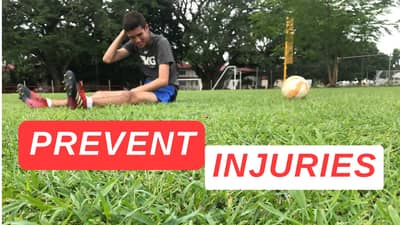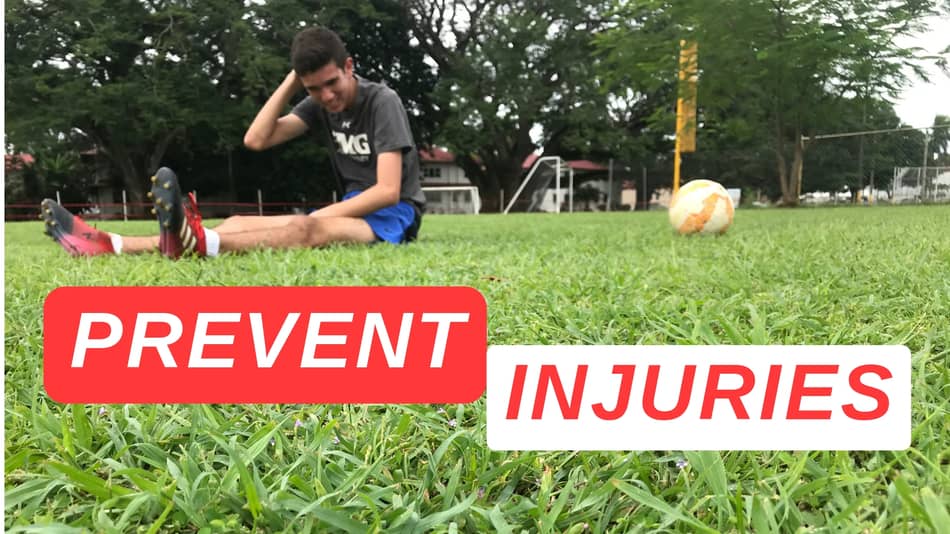
During my time playing soccer I’ve passed through lots of injuries. The worse of all is that most of these injuries were actually my fault and would’ve totally been prevented. I had to learn the bad way from all my experience, and now I want to share you with everything I’ve learned from this, so you won’t stop progressing as a player because of an injury.
So, how do you prevent soccer injuries? These are the first things you need to know:
- Most injuries are because of our fault, and can totally be prevented.
- Injuries can happen either by accident or because of our own ignorance.
- Common sense, ideal protection gear, and strengthening your body can instantly reduce incidence of injuries when playing soccer.
In my article “How Dangerous is Soccer?” I wrote about how dangerous soccer really is. You should read it to have an idea what you are actually facing here. Definitely, there other sports that are more dangerous than soccer, but the “beautiful game” isn’t far behind at all. When you insert into your mind the idea that this sport is physical and that an injury can happen anytime, you’ll be less likely to suffer from injuries because you are taking the preventive measures needed to stay away from them.
This information is fundamental to know for any soccer player. By the simple fact of knowing all of this, will determine how successful your soccer career will be. The big difference between a professional athlete and an amateur is that elite athletes take better care of their body, exactly to prevent injuries that can stop them from improving as a player.
Take Ronaldo Nazario as an example. He is surely one of the best players in the history of the game, but something famous from stopping him to become the best player in history were his horrible knee injuries. Who knows where he could’ve gotten if it wasn’t for the injuries that affected him so badly.
What are the most common injuries in soccer?
According to the NCAA, soccer has an injury rate of 7.7 out of 1000 athletes exposure. This is less than the average from other sports such as baseball, basketaball or football. The most common injuries are muscle strains at 25.8%, followed ligament sprains at 25.3%, contusions at 20.3 %, and concussions at 5 %.
As a player I can confirm this stats with my personal experience. Most of the most of the soccer injuries I’ve had are annoying muscle strains. This type of injury is the one that has left me out of the soccer field for the most time. I also suffered a ligament sprain once (which was very painful), a couple of contusions obviously that heel pretty quick, but very few concussions (not that I have been diagnosed with actually). In the exact order as the stats.
According to this same source, 65% of injuries in soccer happen in the lower limb (feet, ankles, knees, groin, etc), while only about 15% happen in the upper limb. What is curious is that we pay more atention on growing muscle in the upper area when we really need it the most in the lower limb. Some of the injuries I get to see the most every single day are: ankle sprains, hamstring, and ACL injuries.
So, why is all of this even important to know? By being aware of what areas of your body are prone to suffering an injury, you are more conscious of how to treat and prevent injuries in your body. You can’t find the solution when you don’t even know where the actual problem is.
The importance of stretching and warming up
This is one of the most fundamental things to do in order to prevent soccer injuries. I remember growing up with coaches, always telling me how important it was to stretch and warm up correctly, but the only reason they would tell me why was: “It’s good to prevent injuries”. We all know that is true, but we need a real reason to actually do it.
Here are some benefits from stretching and warming up correctly:
- Increase muscle temperature: With warmer muscles, strength and speed increases. Elevated temperature helps with extensions and contractions. Also, stops muscles from over-extending, thus preventing injuries.
- Increases body temperature: With an elevated body temperature, muscles are more elastic, and there are less chances from suffering muscle strains or pulls.
- Increases range of motion: By stretching and warming up correctly, your joints will be able to move through their full range without any danger of suffering from an injury.
- Increases muscle coordination: In order to perform any movement, muscles need to work together. By stretching correctly, coordination between muscles increases, causing movements to be performed correctly; preventing injuries.
- Reduces tension: When inactive, muscles are typically very tense. In fact, most strain muscle injuries happen because the muscles are not prepared to move in their full range. What stretching and warming up do is that they help muscles relax and prepare before the most intense part of your routine.
Are that enough reasons for you to stretch and warm up before doing any type of physical activity? We all know that before playing soccer we have to do it, but we are just too lazy or simply don’t give it the importance that it deserves. The key to always stretch and warm up before a match or training, or even an informal game with your friends, is discipline.
Great stretching routine
I’m going to give you a quick stretching routine that you can do in less that 5 five minutes before any physical activity. The idea is that you have a consistent routine that you can do in a disciplined way every time you step to the pitch.
This are just some examples of the most common stretching exercises I’ve learned during my time playing soccer. Keep in mind you can find countless different exercises in the internet if you consider you need more than the ones I’ll show you to stretch correctly.
Something that characterizes an excellent stretching routine is that it starts by stretching the upper muscles from the body, moving down to the lower limb periodically, until reaching your ankles. Each of the following exercises should be done for 10 consecutive seconds on each side, starting the next exercise the moment you finish one.
Start by stretching your arms
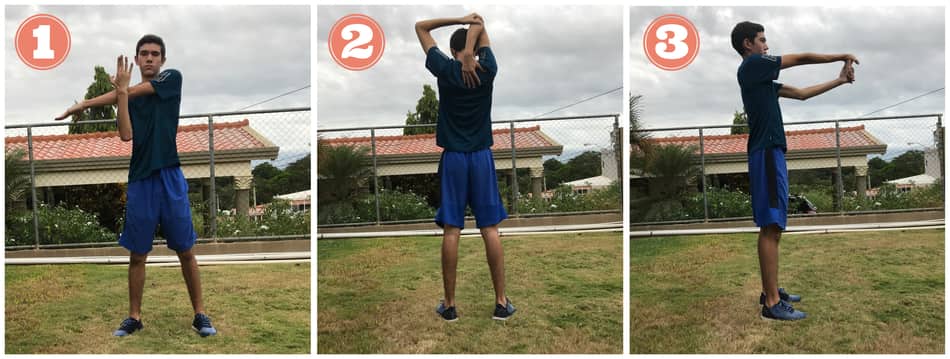
# 1 stretches your triceps and the shoulder joint. Just put one arm on top of the other and stretch backwards (towards your body as you see in the picture).
#2 exercise specifically to stretch the triceps. Bend your right elbow until your hand reaches the middle of your back, then gently reach your elbow with your right hand and pull it towards the head.
#3 stretches biceps and forehand. Turn your arm so that your fingers are facing to the floor, then grab the palm of your hand with the opposite hand and pull gently towards your body for ten seconds.
Always remember that you can start even higher, beginning by moving your neck side to side as if you were saying yes and no. Followed by making some spinning movements with your shoulders to lubricate the joint.
Moving on to the lower limb

This three exercises are great because they help you stretch most of the muscles in your legs, and at the same time they help you practice your balance, something that is very important for any soccer player. Try making this exercises during 10 straight seconds without falling down. If you want, you can lean on a post or another teammate to better do the exercise and stretch the muscles in the best way possible.
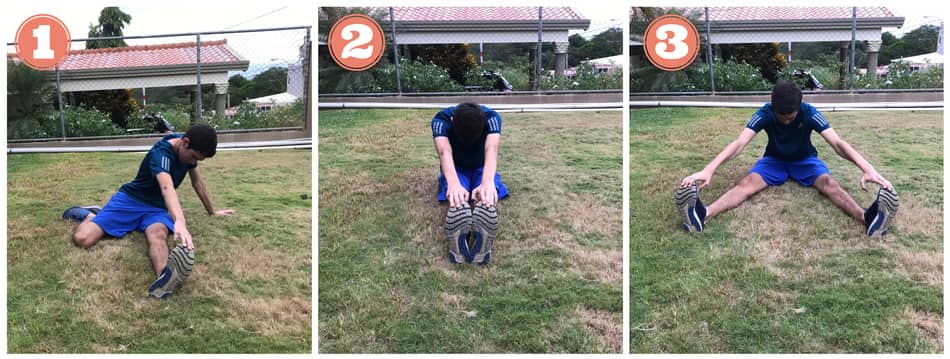
Lastly try doing this three exercises sitting on the floor. These are my favorites of all because you truly feel how your muscles are stretching correctly. For beginners it might be hard to do, but after some time practicing them you’ll become more and more flexible.
Warm-up routine
Warming up is as important as stretching. I like doing my warm ups before I stretch, in that way my muscles are already heated up and can stretch in a better way. For some people there is no science behind a warm-up. Most people just like jogging around the field for about ten minutes and after that they are already warmed-up ready to play.
There is nothing bad with warming up in this way, but we can definitely warm up a lot better than that. The following exercises are part of what I call “dynamic warm up”. What makes dynamic warm up so good is that it helps the body get warm and prepared by doing movements that you would actually do in a soccer game. Some dynamic warm ups look like this:
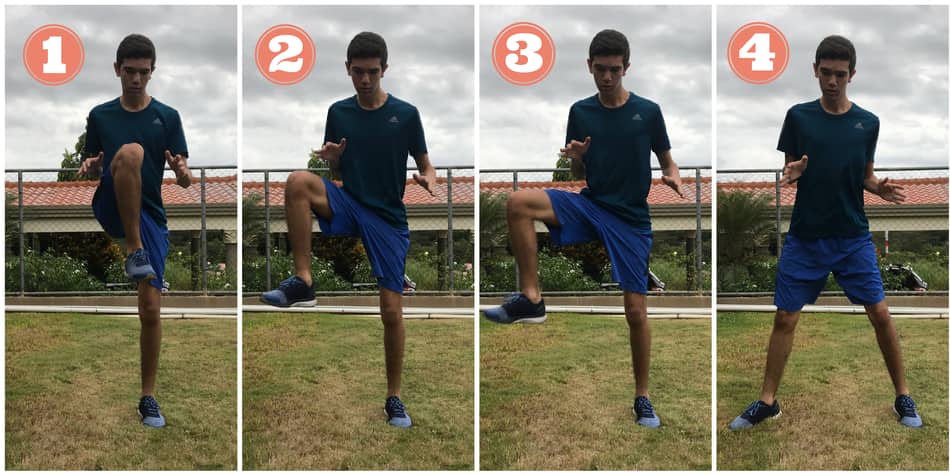
My favorite of all is what I call the “outside scissors”. You start by raising your right leg to the height of your chest, then moving it to the outside of your body, until the leg is finally down to the floor again as you see in the picture. Something very important to know when doing this exercise is that you have to do it fast, at a speed that you would normally move in a soccer game.
Another tip for this exercises is that, at the moment one foot touches the floor, immediately you have to raise the opposite leg to the height of your chest and repeat the exercise. All of this has to be done without moving the standing leg at any time, the only leg that shall move is the one in the air. The exercise can be done in your position or moving forward. Try doing it for 30 consecutive seconds.
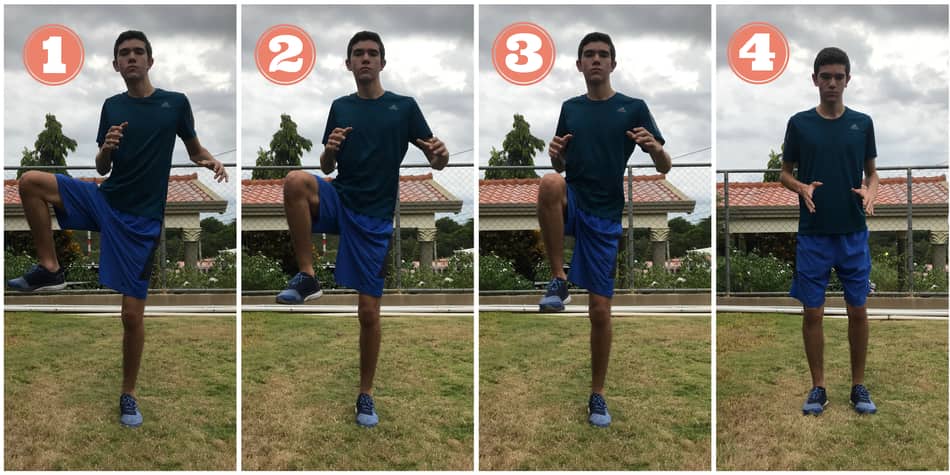
This is called the “inside scissors”. Basically, you have to do the same movement as the outside scissors just that reversed. This exercises can also be done in the position or moving forward. For beginners, I would recommend doing it moving forward because it is easier to do.

This warm up is what I call “The knees up”. The exercise is to simply jog in your position raising your legs to the hands that should be at the same height as the chest. Try doing this exercise for 30 seconds straight, in your position, moving forward or backwards if you want.
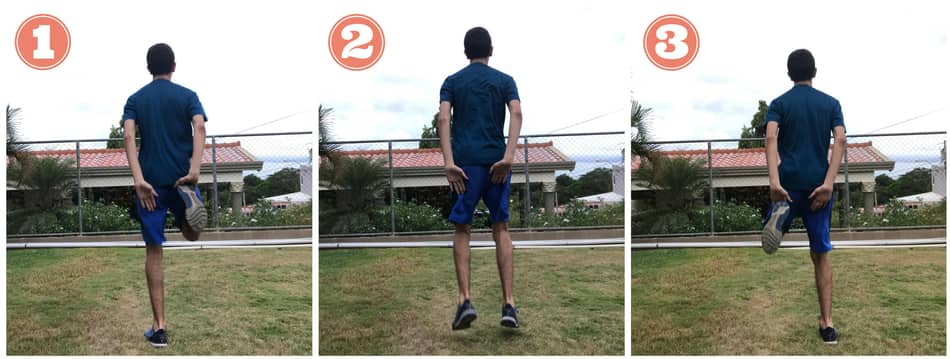
This one is “The heels to the butt”. Simply jog in your position or moving forward, raising your heels, and touching your hands that should be at the same height as your glutes.
Injuries from badly chosen soccer cleats
One of the best ways to prevent injuries is by choosing the correct gear to play the game. Something that is fundamental to know for any player at any level is the different playing surfaces and what type of shoe to buy to play in each one. If you are not well informed in this topic, you are in a serious risk to suffer an injury.
According to brands, these are the different playing surfaces you can find when playing soccer:
- Indoor
- Turf
- Artificial Grass (AG)
- Firm Ground (FG)
- Soft Ground (SG)
I’ll briefly talk about each one and what shoe to use.
Indoors and Turf
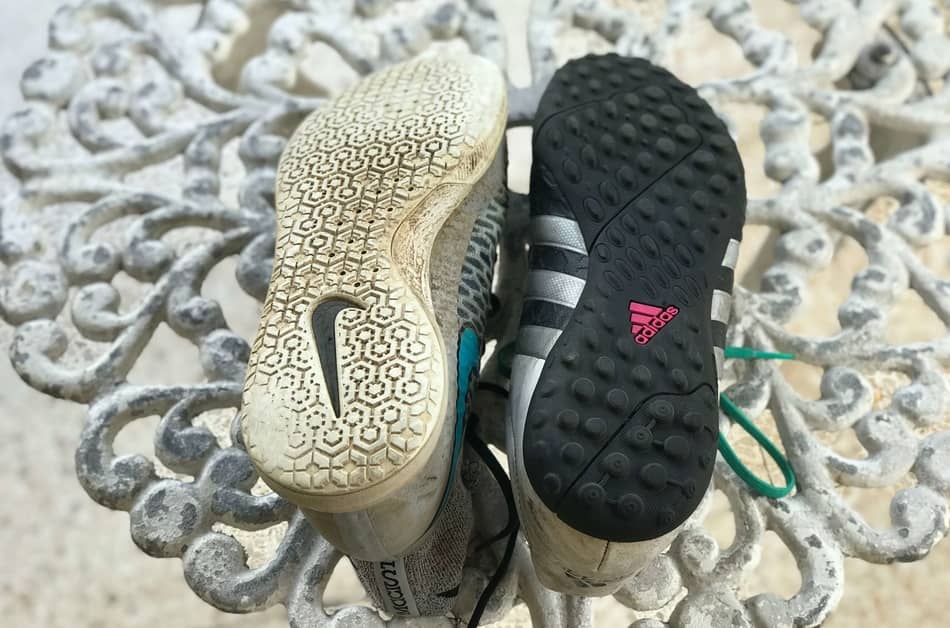
Basically, indoor is a futsal soccer field. They are not made of grass at all. Some indoor fields might be made of cement or of a wooden floor similar to the one used in the NBA. The correct type of shoe to use in this surface is the one on the left. It will give you to traction you need to play in a dry soccer indoor soccer field or in the streets.
In the other hand, Turf is kind of a low quality synthetic grass carpet that sits on top of a hard surface. This surface is usually very abrassive and located in an outdoor location (meaning that it can be wet). Many people think that they can use an indoor soccer shoe on turf, however this is not the case. In my article “Can you wear indoor soccer shoes on turf” I explain why that is not a good idea, go check it out. The correct shoe to use is one with a turf soleplate like the one on the right.
Artificial Grass (AG)
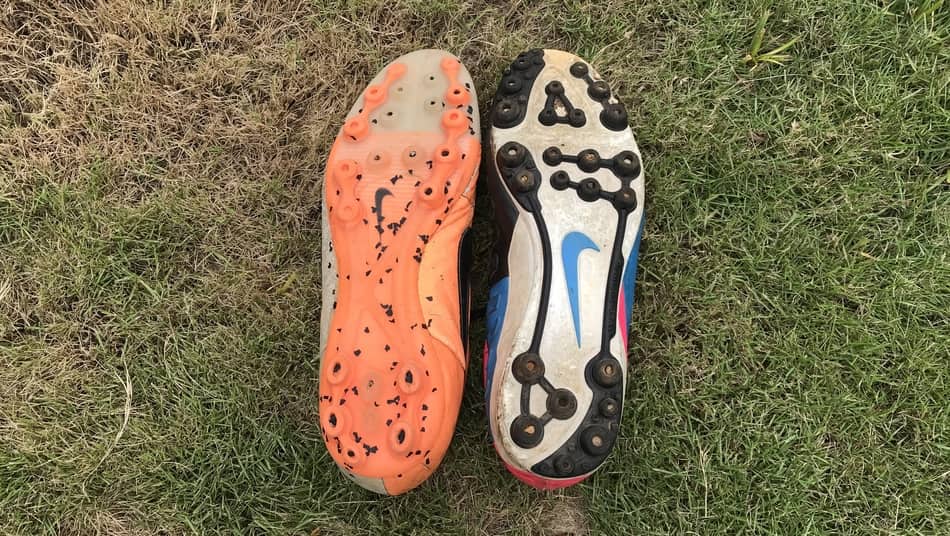
You might be asking yourself: isn’t turf and artificial grass the same? Absolutely not. I wrote an article on the topic: “The big difference between turf and artificial grass”. It is important you know that difference and learn what boot to choose to play on this surface.
In the picture above, you can see two pair of soccer cleats with an AG soleplate. This is the correct soleplate to use on AG, although some people say you can use FG too.
Firm Ground and Soft Ground
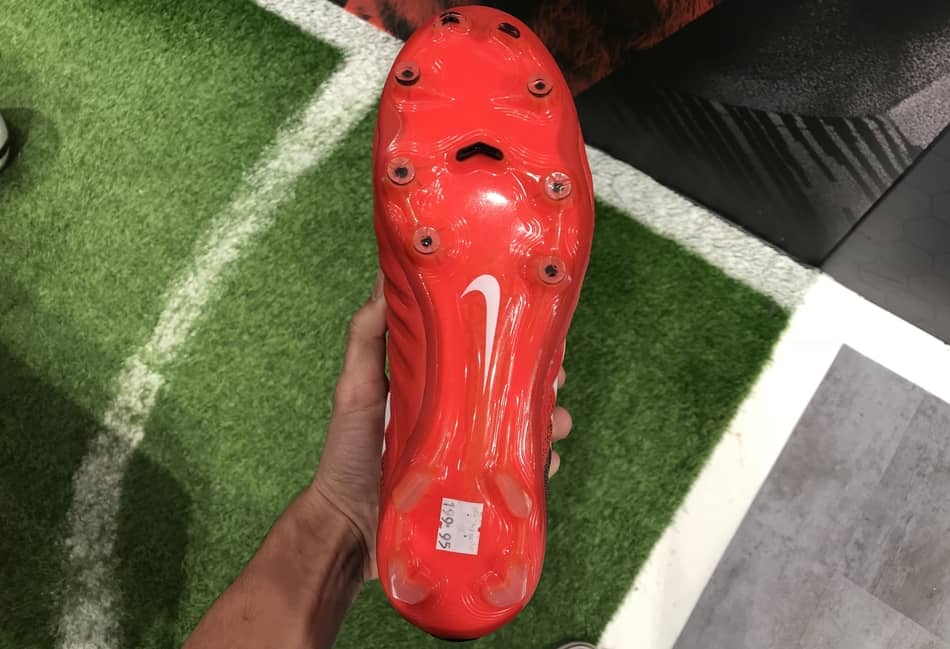
In the image above you can see a pair of soccer cleats with an FG outsole. This shoe can be used either in hard or soft natural grass. You need to understand that, when playing on grass, we’ll find different levels of quality. There is grass that is professionally treated (where the pros play), and grass that has a more hard, dry base. In the last one, a pair of cleats like the ones above will work perfectly.
However, if you actually have the chance to play in a soft, professional grass you should buy a pair of cleats with an SG outsole. An SG pair of boots is the one that has a soleplate with removable metal studs. Even though, an FG pair of boots will work just fine.
If you want to learn the great advantages natural grass has over turf, read my article: “The Reason why all soccer players prefer grass over turf”.
Consequences of not doing Gym/Weight Room exercise
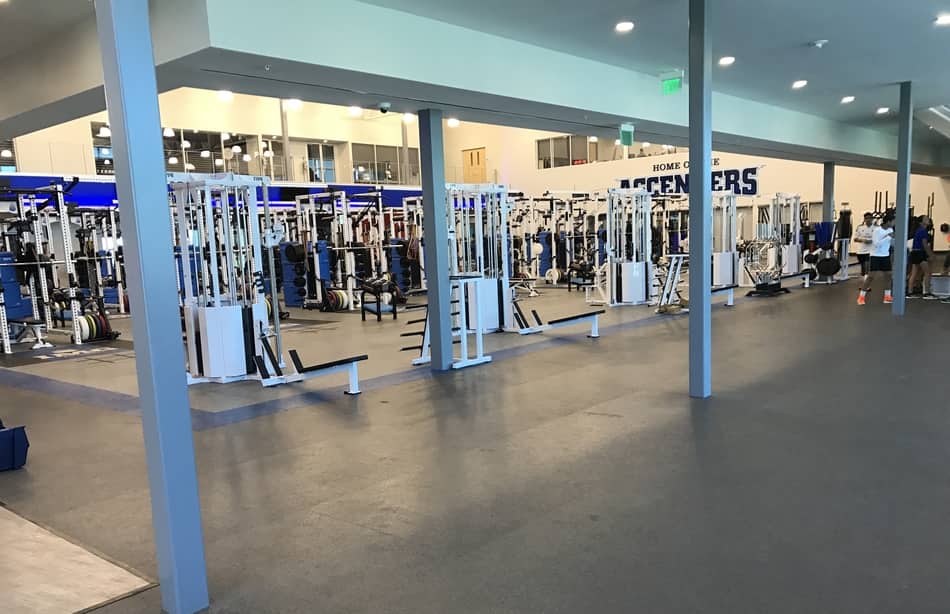
By own experience, I can say this is one of the most important things I didn’t know to prevent injuries, and probably the reason why I got injured so frequently. The first and most important reason why all professional players complement weight training with soccer training, besides enhancing performance, is to prevent injuries.
I remember that a couple of years back I started playing for a very disorganized soccer team. I was a teenager and it was the first time I was about to play a federated district-level soccer tournament. My team was not well planned. We used to practice everyday from monday to friday in the soccer field playing 11 vs 11…. only that. No type of specific passing, shooting, dribbling drills or anything similar.
At the time I did absolutely no type of weight training or exercise at the gym to strengthen the muscles. I began the season well, I was a starter in the team and we were playing 70 minutes long games. When we reached about the sixth game of the season I began to feel a slight discomfort in my groin. It wasn’t something that bothered me that much, so I kept playing.
With every practice and every game, the pain became more intense. In my seventh game of the season, I had to quit the soccer field because the pain in the groin was already big enough to stop me from performing as I wished.
I went to the doctor, and I was diagnosed with a strain in a muscle called “iliop-soas”. I was out for about 5-8 weeks at least. Muscular injuries are the worse. They take a long time to recover, you can’t do any activity during that period, and after the muscle is already recovered, you’ve got to make strengthening exercises so it doesn’t get injured again.
As I said at the beginning, muscular strains are the most common type of injuries in the sport. What is best, is that they can totally be prevented with a good weight lifting routine.
According to my doctor and physio, I got injured because my muscles were not strong enough to support the amount of physical effort I was demanding from them. If you want to prevent injuries, make sure to have a good training routine to strengthen your muscles.
Soccer is a sport that demands a lot physical effort, you need to prepare your muscles appropriately, otherwise, you’ll be more outside than inside the field.
Basic Exercises to prevent injuries
You don’t have to necessarily buy a gym membership in order to strengthen your muscles correctly, to avoid injuries. You can use whatever you have with you. I came up with some exercises you can do by your own with things you have in your house or that you can easily buy at a near local store.
Exercise with ankle weights
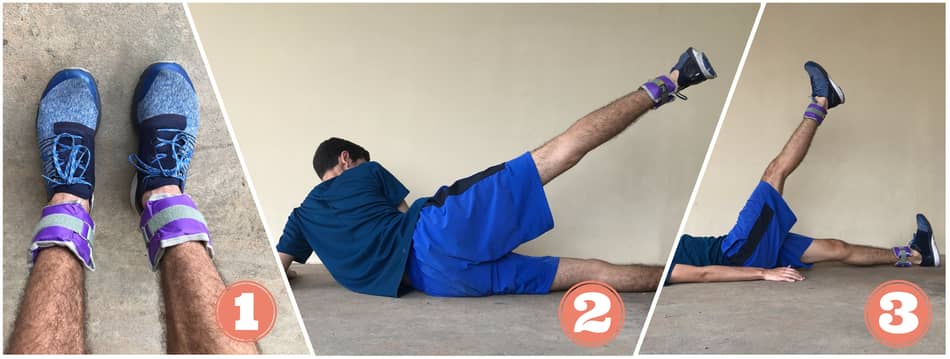
Ankle weights are awesome to fortify your leg’s muscles. In image #1 you can see a simple 5 pound pair of ankle weights like this ones on amazon: click here to see them. You can buy a pair of this ones for cheap. Once you feel you have dominated the weight, you can try purchasing heavier ones.
You can do exercises #2 and #3 with a weight of 5 pounds in each leg. This are very complete exercises because they help you strengthen all the muscles of that area. #3 is specially good to avoid injuries due to overuse caused by kicking the ball.
Dumbbell exercises

#1 are famous squats: Squats is probably one of the best, if not the best, exercise for your legs. It is super complete and will give you more power and strength when playing the game. Try starting with a light weight like 10-15 pounds and add more weight progressively. 4 sets of 10 reps will be enough.
#2 are walking lunges. They are similar to squads, just that instead we are working with one leg at a time. 3 sets of 8 steps with each leg will help.
#3 is dead lifting: Also, super complete exercise. In the picture you see I’m using tiny dumbbells, but usually you should be able to lift more than that. This exercise is awesome to strengthen hamstring, which is one of the most common muscles injured in soccer.
Note: this are super simple exercises to fortify your legs to prevent injuries. You can always search for more, the internet has countless of things you can do. Just be creative and get the most out of what you have.
Remember: Stronger legs = less likely to get injured.
Protection Gear is vital
Soccer is a contact sport, as in any other sport of this type you must use protection gear to protect yourself from any accidents. By far, the most important thing related to protection gear to remember every time you step into a soccer field is to absolutely always wear shin guards.
You have no idea how many times I was kicked so hard in the shin, but thanked god I didn’t feel anything because I was wearing shin guards. You can check the shin guards I recommend by clicking here.
There is no excuse not to wear them, there are from all shapes, sizes, price, and preferences. Just find a pair that works for you and use them always, it’s not a big deal. Some people might argue that they feel uncomfortable. To that people I say that it is a lot more uncomfortable having a broken tibia, and not being able to play soccer ever again.
The only mandatory protection gear you have to use in a soccer game are shin guards. However, there is other protection gear I recommend that can minimize even more the chances of getting injured.
Checking the field and environment
Here is where the part of “common sense” I mentioned at the beginning takes a role. Always, you step into a soccer pitch, either it is to train or a game, you need to check the conditions of the field. A field in bad conditions contributes considerably to the likelihood of players get injured.
Common examples of bad field conditions are:
- Natural grass fields excessively wet and flooded.
- Soccer pitches that are not well leveled or that present an irregular surface.
- Artificial grass fields that have weared off due to poor maintenance.
Another aspect you have to check out is the environment of the game. We’ve all been at soccer games where things heat up a little bit between players. How players act in the field can determine if a player is in danger getting injured. For example, if you feel like there is an excessively aggressive environment during a game, it is a good idea to step away or speak with your coach or the referee about it.
Seems logic right? Why would you play soccer in a pitch that is in bad conditions and has an aggressive environment between players? As I said in the beginning, common sense is probably the best way to prevent injuries in this sport.
Knowing your limits
Probably one of the reasons why my injuries took so long to heal was because I worsen them by myself. I knew at a moment that my body wasn’t able to give much more, but I still didn’t stop playing and wanted to play every minute.
I know I’m not alone in this position. We all know when our body can’t give more, but we want to keep going to become better and better. This is not bad at all, but is not very smart either. If you get injured for overtraining, at the end, your intentions of becoming better by training more have done more bad than good.
Know yourself, your body, and your limits. The body speaks to you constantly, pay attention to him, and take a step to the side when needed. It will heal quicker than if you keep going when you know you can’t give more.
Do not be soft
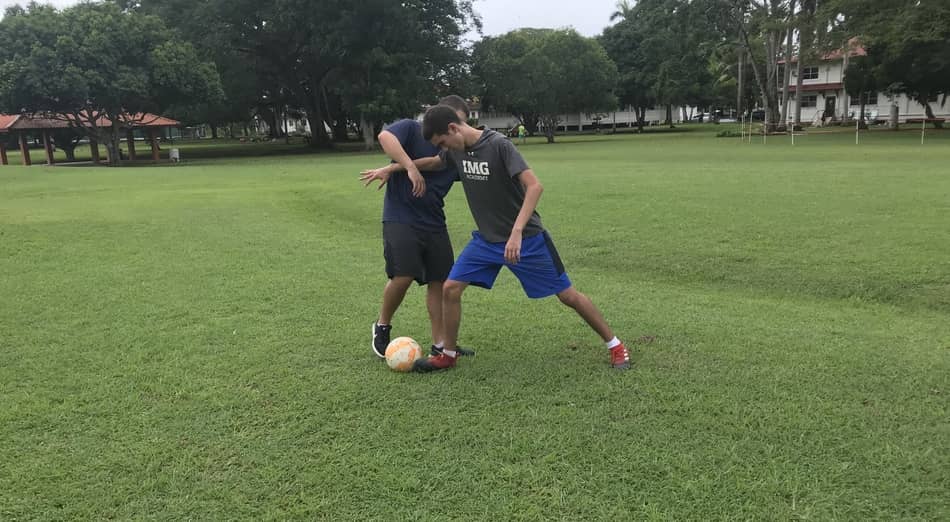
Probably one of the biggest mistakes when playing soccer is being soft. What I mean by being soft is not playing with intensity and not entering the plays with security and force.
Imagine this situation: Two players are running towards a loose ball. It’s a 50/50 ball. One player reaches the ball with power and authority, and the other slightly reaches the ball with his foot because he is scared that he will get injured. Who do you think has the more chances of getting injured in this case? Yes, the second player.
This not only happens in 50/50 balls, but in every aspect of the game. If you don’t put your body hard, play strong, and with confidence, you will be thrown side to side like a puppet. Probably resulting in an easy injury.
Fueled body = Less injuries
About 65% of the human body is made out of water. It is extremely important to stay well hydrated before, after, and during soccer games and training. A good hydration considerably helps your muscles to perform at their best level without suffering from any damage. Obviously, other factors like getting good sleep and having a proper nutrition are things that play an important role on how resistant can the body handle and resist physical activity.
Always go see your doctor
Every time you feel even a slight discomfort when playing the game, consult with your doctor before taking any action. They are the person that is best suited to help you in case of an injury. If you take action by yourself, and start doing random exercises, you might be running the risk of making the injury even worst.
Sports medicine doctors and physiotherapist are people trained to help athletes achieve their best level at the game while staying physically healthy. Follow every single step and advice they give you, and I promise injuries won’t be something that stop you from improving as a player.
Related Questions
What is the percentage of injuries in soccer? In average, 65.6% of injuries happen in the lower limb of the body. The areas that are mostly affected are: knees, ankles, hamstring, foot, groin, among others. In order to prevent this injuries, try giving priority to the lower limb when strengthening the body at the gym.
Is soccer a safe sport to play? I wrote an article called “How dangerous is soccer?” in which I talk about how soccer is significantly less dangerous than other sports, however it is still a contact sport so an accident can happen at anytime. I also compare it to other popular sports like baseball, basketball, and american football.

